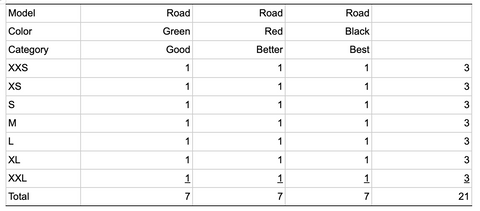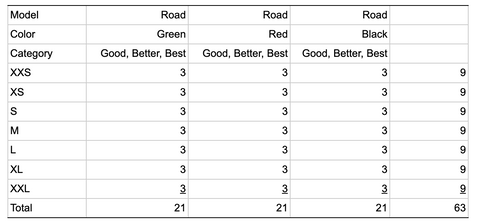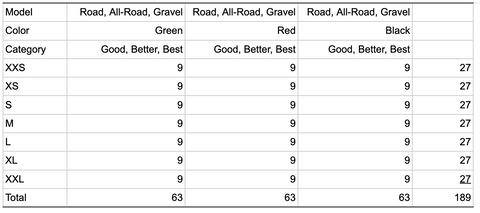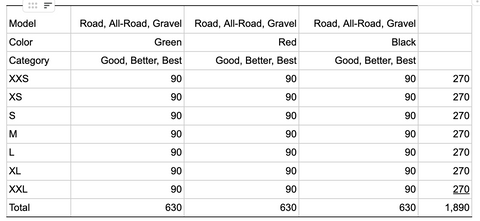The cost of a Bike For Every Price
The cost of a bike for every price
The Bike for Every Price convention is that if the model, color, category and size is not available on site and ready to ride out the door (or ship out to the door of the customer), the sale will be lost. The belief holds that to always make the sale, the bike shop or bike brand must have at least one of each model, in the offered selection of colors, in all sizes and for each category. The retailer or brand is making a large investment in a range of models, colors, categories and sizes and hoping that the right person is going to walk in the door within the next twelve months and make a purchase.
N + 1 Thought gets expensive and risky very quickly
In order for a direct to consumer brand to offer just one model for each color, each category and each of seven sizes, it will have to purchase 21 bikes. To offer one model in three colors, three categories and all seven sizes it will have to purchase 63 bikes. Offering a larger inventory gets exponentially expensive and risky very quickly. But N+1 Thought holds that a broader inventory increases the chances that the brand will have the model, size, color and category that consumer is looking for when he or she arrives at the site. Is N+ 1 Thought worth the risk?
Broad but very shallow, risky and capital intensive
Any business school student will tell you that it is not. For a brand to have one Road, one All Road and one Gravel bicycle available in three colors, three categories and in seven sizes, it will have to buy 189 bicycles. That is a huge investment in an inventory that is broad but also very shallow: there is only one All Road Red Better M bicycle in inventory and once it is sold, other customers are out of luck and will go elsewhere. Additionally, the brand ties up tens of thousands of dollars in inventory that could quickly become obsolete: witness the move from rim to disc brakes and 12 speed. And inevitably, some if not all of the working capital needed to purchase the inventory is going to be borrowed money which incurs interest expense and debt repayment obligations.
Appendix: One model one color one category seven sizes

A direct to consumer bike brand or bike shop will have to buy 21 bikes just to have just one Road bicycle available in each color, each category and for each of the seven sizes. This is expensive, it takes up space and it is risky. Assuming that the wholesale price of each bike is a $1,000, this means a $21,000 investment in inventory. The brand is betting cash that there will be one enthusiastic five foot tall cyclist who wants to purchase one Road Red Better XXS bike in the next twelve months and that he or she will be happy with the only color available: red.
Appendix: One model three colors three categories seven sizes

A direct to consumer bike brand will have to buy 63 bikes to have one Road bicycle available in all three colors, all three categories and in all seven sizes. Assuming that the average wholesale price of each bicycle is $1,000, this means a three fold increase in inventory investment to $63,000. This is also a three fold increase in storage space requirements and risk. The brand is putting at risk tens of thousands of dollars to be able to have one Road Best XL bike available in Green, Red and Black for that dedicated six foot one inch cyclist who has a color preference.
Appendix: One of three models all three categories all seven sizes

A direct to consumer bike brand will have to buy 189 bikes to have one Road, one All-Road and one Gravel bicycle available in all three colors, all three categories and in all seven sizes. Assuming that the average wholesale price of each bicycle is $1,000, this means an inventory investment of $189,000. This is also another three fold increase in storage space requirements and risk. The direct to consumer brand is tying up hundreds of thousands of dollars to be able to have one Road Best XL bike, one All-Road Best XL bike and one Gravel Best XL bike available in all three colors and all three categories for that dedicated six foot one inch cyclist who is not sure which model to buy.
Appendix: Ten of three models three colors three categories seven sizes

A direct to consumer bike brand will have to buy 1,890 bikes to have ten Road, ten All-Road and ten Gravel bicycles available in all three colors, all three categories and all seven sizes. Assuming that the average wholesale price of each bicycle is $1,000, this means an inventory investment of $1,890,000. This is also a ten fold increase in storage space requirements and risk. The direct to consumer brand is tying up millions of dollars to be able to have ten Road Best XL bikes, ten All-Road Best XL bikes and ten Gravel Best XL bikes available in all three colors for the ten, dedicated six foot one inch cyclists who might (or might not) visit the site.
